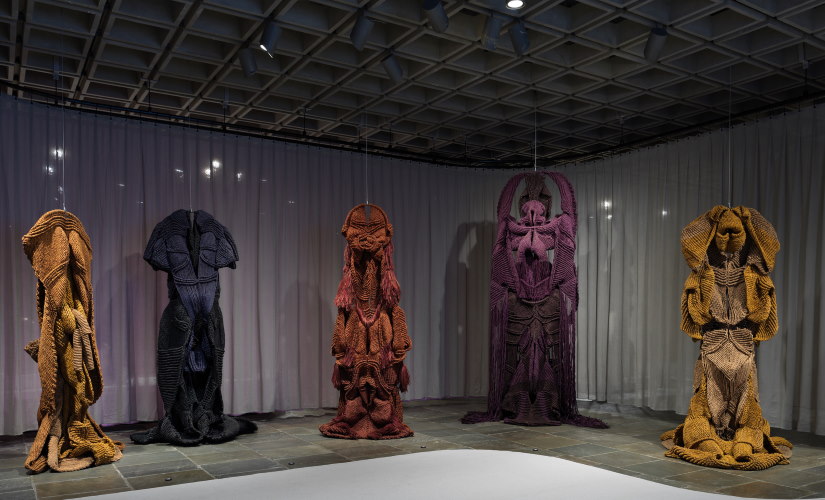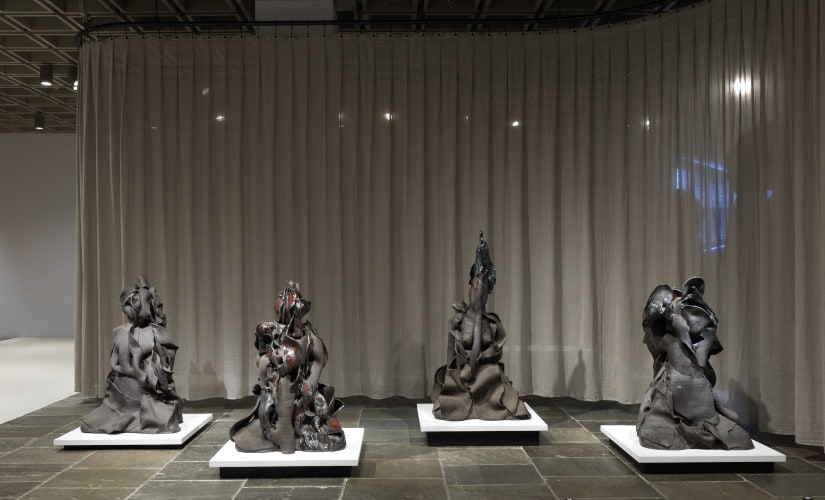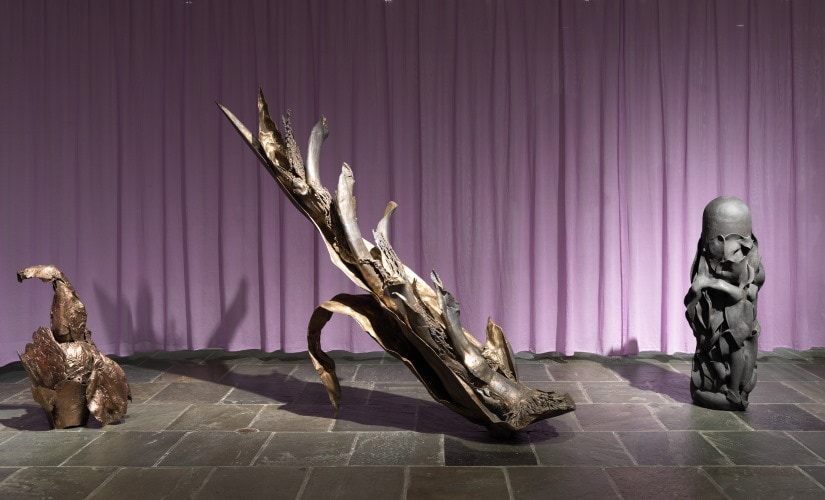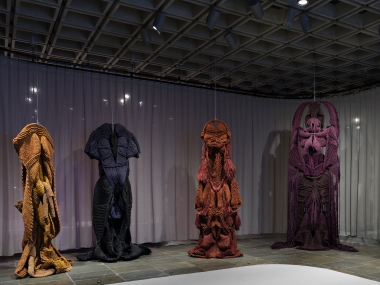Mrinalini Mukherjee’s sculptures belong in the outdoors. Wild, free-flowing and suggestive of terror-inducing hybrid organisms, her work challenges the slickness of built environment, including a museum. Mounted inside New York’s The Met Breuer, her first retrospective in the United States is somewhat reminiscent of the ‘exotic’ tag that her work has often been categorised into. At the museum, her sculptures — made of natural fibres, ceramic and bronze — are placed over rugged-looking tiles, piles of bricks or obscure-looking white plates. Screens of back-lit curtains surround the sculptures, a gentle ambience-making that adds an element of ‘other’ to the works. The setting suggests an attempt to fit her works, which draw upon the abundance of nature, into the format of a ‘white cube’. But Mumbai-born Mrinalini Mukherjee was a nature’s child, who was heavily drawn towards open spaces, especially being an avid traveller. She developed an affinity with nature in her childhood as she divided her time between Santiniketan, where her father, the painter Benode Behari Mukherjee, taught; and Dehradun, where her mother, the sculptor Leela Mukherjee, was a school teacher. Even though she studied painting and mural design at Vadodara’s Maharaja Sayajirao University, she chose natural fibre as her primary medium of expression that had little to do with formal training. It was for the university’s Fine Art Fairs, established by her teacher KG Subramanyan during the 1960s, that she made her first jute-based work. [caption id=“attachment_7248521” align=“alignnone” width=“825”]  Installation view of Phenomenal Nature, Mrinalini Mukherjee at The Met Breuer, 2019. All images courtesy of The Metropolitan Museum of Art[/caption] Some of her earliest fibre works, from the 1970s, are part of the retrospective, including two anthropomorphic-looking wall exhibits, titled ‘Black Formation’ and ‘Squirrel’. The latter, sourced from New Delhi’s Kiran Nadar Museum of Art, is made of hemp, jute, cotton, sisal, bamboo and carpet brushes. In their scale and aesthetics, these sculptures are marked by daring imagination on the part of the artist. There is a throbbing sense of fecundity in these works, as if Mukherjee is invoking a world that is not known to us. Potent representation of pagan deities; abstract forms of humans, plants and animals; invocations of sexuality and life-making processes — Mukherjee’s world belongs to “Phenomenal Nature”, as the exhibition is titled, while being shrouded in mystery. The charged visual quality of her fibre-based sculptures is enhanced by the way they are installed. They range from freestanding exhibits to being hung from the ceiling. Some of them occupy parts of the floor and wall; one sculpture in the exhibition is curled up on the floor. Dillu, as she was fondly called, was known to be highly particular about the installation process of her work. For example, a detailed instruction manual for her famous sculpture ‘Yakshi’ reads: “The sculpture has to be viewed from all sides and needs space all around.” For an artist who grew up in the rugged landscape of Santiniketan and the foothills of the Himalayas in Dehradun, the idea of space as an expanding presence is, therefore, reflected in the treatment of her finished artforms. This is obvious in all the mediums that she worked in, including ceramic, which she began experimenting with during the 1990s, followed by bronze sculptures. One of her most powerful works from that period is ‘Night Bloom’, which shows a nude female deity seated amidst the largesse of a vegetal setting. Like her other sculptures, ‘Night Bloom’ also emanates an aura, where the image appears iconic, as if drawn from mythology or ancient Indian sculptures. The assertion of the female form and her sexuality are equally potent in her other sculptures, such as ‘Woman on Peacock’ or ‘Black Devi’, which are also part of the exhibition. [caption id=“attachment_7248531” align=“alignnone” width=“825”]  Installation view of Phenomenal Nature, Mrinalini Mukherjee at The Met Breuer[/caption] In Mukherjee’s fibre and ceramic works, the diverse life-forms — such as humans, gods and goddesses, animals, plants and other beings that defy recognition — do not seem disparate. These are fused together in a symbiotic relationship, where the difference between ‘us’ and ‘them’ or ‘me’ and ‘you’ has been dissolved. This is an interesting takeaway from her work at a time when the public discourse in many parts of the world, including in India and the US, has been sharply divided along the lines of majoritarian, liberal and minority viewpoints. The collapsing of boundaries finds a radically different expression in her bronze sculptures, which she began working on during the early 2000s. The suggestion of human, animal or divine presence has been done away with. The organic-looking bronze works appear to be leftovers of a molten eruption. Often, they are made to look like snapped branches of a tree suspended mid-air. For Shanay Jhaveri, the exhibition’s curator, they belong to a “prehistoric time” or “palaeontological period”. In Mrinalini Mukherjee, the medium and its thrilling possibilities are paramount. In all of these, the physical act of using her hands was most important as she worked her way through fibre, clay or metal — a laborious process that often took a long time for a work to complete. Her sculptures are known for their distinct textural quality, with a tactile feel that seems indispensable to the forms that she created. “My work is media-based. I like to do what’s possible with the medium,” she said. But for the artist, who also made landscape prints and watercolours, her practice was more than a vocation. It was, to use a cliché, a way of living, as she once summed it up: “my work is physical—my body, my materials, the way of life, the environment, all work together.” [caption id=“attachment_7248551” align=“alignnone” width=“825”]  Installation view of Phenomenal Nature, Mrinalini Mukherjee at The Met Breuer[/caption] Mukherjee began exhibiting internationally during the 1980s, with major shows in Paris, London, Oxford, Havana and Sydney. In 2015, New Delhi’s National Gallery of Modern Art organised a retrospective of her sculptures, which, unfortunately, coincided with her passing away, at the age of 65. It was only after her death that her work began to be shown in the US. In his introductory essay to a monograph on the artist, Jhaveri refers to Mukherjee’s practice “as a series of radicalised interventions in its adaption of craft”, an area where there “was an absence of peers working in a similar mode” in India. Despite that, the Met retrospective, which has mounted nearly 60 sculptures by Mukherjee, notes that some of the initial reactions to her work were “culturally reductive”, with Jhaveri pointing out attributes such as “mythic”, “exotic” and oriental being used for her work. “She did, of course, face the kind of parochial and gendered dismissal from certain quarters encountered by other fibre artists,” he adds, recalling the fact that Mukherjee was working in a market dominated by male sculptors and her choice of medium was craft-based, which added another layer of bias. The US retrospective addresses these problematic responses to her practice, even though the museum’s decorative setting blunts the directness of her sculptures. The exhibition concludes on 29 September. Ankush Arora is a Delhi-based freelance writer
Mounted inside New York’s The Met Breuer, Mrinalini Mukherjee’s first retrospective in the United States is somewhat reminiscent of the ‘exotic’ tag that her work has often been categorised into.
Advertisement
End of Article


)
)
)
)
)
)
)
)
)



